3 Mar 1942
Pacific Ocean
Pacific Ocean
- USS Grayback fired a torpedo at a Japanese transport in the Philippine Sea off Tinian, Mariana Islands; the torpedo missed. ww2dbase [Grayback | Philippine Sea | CPC]
5 Mar 1942
Pacific Ocean
Pacific Ocean
- USS Grayback sank a Japanese transport and an escort vessel in the Philippine Sea off Guam, Mariana Islands, hitting them with 2 of 3 torpedoes. ww2dbase [Grayback | Philippine Sea | CPC]
25 Mar 1942
Pacific Ocean
Pacific Ocean
- USS Grayback fired a torpedo a Japanese patrol vessel in the Philippine Sea off Ryukyu Islands, Japan; the torpedo missed. ww2dbase [Grayback | Philippine Sea | CPC]
12 May 1942
Pacific Ocean
Pacific Ocean
- Shokaku made rendezvous with Kuroshio, Oyashio, and Hayashio in the Philippine Sea; Ushio and Yugure were released as her escorts. Shokaku avoided more US submarines during her final leg home. However, with the high speeds and gashed bow, the ship took on so much water that she nearly capsized en route. ww2dbase [Yugure | Shokaku | Philippine Sea | CPC]
21 Jul 1943
Pacific Ocean
Pacific Ocean
- USS Haddock fired 8 torpedoes at a convoy, sinking transport Saipan Maru and damaging 3 others in the Philippine Sea with a total of 7 hits. ww2dbase [Haddock | Philippine Sea | CPC]
18 Dec 1943
Pacific Ocean
Pacific Ocean
- USS Grayback attacked a four-freighter Japanese convoy escorted by three armed vessels in the Philippine Sea after nightfall and into the next date, sinking freighter Gyokurei Maru, sinking escort vessel Numakaze, and damaging several other ships; 6 torpedoes were expended in this attack, 4 of which hit. ww2dbase [Grayback | Philippine Sea | CPC]
19 Dec 1943
Pacific Ocean
Pacific Ocean
- USS Grayback sank a Japanese patrol vessel in the Philippine Sea, hitting her with 3 of 4 torpedoes. ww2dbase [Grayback | Philippine Sea | CPC]
16 Jan 1944
Pacific Ocean
Pacific Ocean
- USS Whale made contact with a Japanese convoy she had been searching for for the past two days in the Philippine Sea, sinking Denmark Maru with 1 of 3 torpedoes fired, but suffered damage from depth charges. USS Seawolf herded Tarushima Maru toward USS Whale, and USS Whale successfully sank Tarushima Maru with torpedoes. ww2dbase [Whale | Philippine Sea | CPC]
17 Jan 1944
Pacific Ocean
Pacific Ocean
- USS Whale claimed sinking a Japanese freighter in the Philippine Sea, hiting her with 3 of 9 torpedoes fired. ww2dbase [Whale | Philippine Sea | CPC]
27 Feb 1944
Pacific Ocean
Pacific Ocean
- USS Grayback sank freighter Ceylon Maru, hitting her with 1 of 2 torpedoes. She was sunk by the subsequent depth charging by aircraft and anti-submarine craft 100 kilometers southeast of Okinawa, Japan. ww2dbase [Grayback | Philippine Sea | CPC]
19 Jun 1944
Pacific Ocean
Pacific Ocean
- At dawn, flagship Taiho, Shokaku, and Zuikaku launched launched combat air patrol fighters. At 0756 hours, the first major strike force was launched (48 fighters, 53 bombers, and 27 torpedo bombers; led by Lieutenant Commander Akira Tarui). At 0810 hours, USS Albacore hit Taiho with a torpedo in the starboard bow, but Taiho's damage control team allowed the carrier to remain in formation; destroyer Hatsuzuki was left behind to hunt for USS Albacore. At 1020 hours, Zuikaku launched a second strike force (4 fighters and 4 bombers) to join the fourth big raid on on US Navy Task Force 58. Meanwhile, Taiho suspended flight operations due to gas vapor issues and Shokaku was busy with combat air patrol duties through well past 1100 hours. At 1100 hours, Shokaku began recovering 10 fighters; while the recovery process continued, at 1122, Shokaku was hit by three torpedoes from USS Cavalla on the starboard side; two forward near the switchboard and generator room, one aft of amidships. Large fuel fires were ignited in the hangar and No. 1 boiler room went offline. Shokaku remained underway, but began to list to starboard. Counterflooding over-compensated, giving her a port list. Meanwhile flooding and heat of the fires forced shutting down of the boiler rooms. She continued to settle forward. Though damage control initially hoped to save her, the flooding forward and the fires intensify in the following hours. By 1210 hours Shokaku had come to a halt when fires detonate an aerial bomb on the hangar, setting off volatile gases from a cracked forward tank. Large induced explosions wrecked the carrier, and hope began to fade. The list to port and bow trim both increased. Carriers Zuikaku and Taiho were ordered to leave damaged Shokaku behind, while cruiser Yahagi and destroyer Urakaze remained with Shokaku. At 1350 hours, Shokaku strike planes returned, but were ordered away, redirected to Zuikaku and Taiho. By the time Taiho's aircraft returned, the gas vapor leak problem became extremely worrisome, and some of Taiho's aircraft were redirected to Zuikaku. At this time Captain Hiroshi Matsubara of Shokaku had ordered the carrrier abandoned and the crew mustered on the flight deck for flag lowering. However, before the evacuation can proceed far, the bow dipped under and water pours into No. 1 elevator well, causing the carrier to corkscew to port and up-end. Shokaku went down by the bow at 1401 hours, stern raised high. Between 1408 and 1411, four underwater explosions were registered. 58 officers, 830 petty officers and men, 376 members of Air Group 601, and 8 civilians were killed, totalling 1,272 deaths in the sinking of Shokaku. Light cruiser Yahagi and destroyers Urakaze and Hatsuzuki rescued Captain Hiroshi Matsubara among 570 other survivors. At 1432, another disaster struck as the gas vapor aboard Taiho detonated; the explosion engulfed the flagship. Zuikaku was ordered to proceed while Vice Admiral Jisaburo Ozawa to transferred his flag to cruiser Haguro. At the end of the day, the Japanese Navy lost 244 of the 374 aircraft that it had launched during this battle. The US Navy had only lost 20 aircraft. ww2dbase [Cavalla | Mariana Islands Campaign | Jisaburo Ozawa | Taiho | Shokaku | Zuikaku | Haguro | Albacore | Philippine Sea | CPC]
20 Jun 1944
Pacific Ocean
Pacific Ocean
- At 1130 hours, the Japanese Mobile Fleet, withdrawing west from the losses sustained on the previous day during the Battle of the Philippine Sea, paused to refuel from tankers while Vice Admiral Jisaburo Ozawa transferred his flag aboard Zuikaku. At 1500 hours, cruiser Atago reported seeing an American scout plane, and Ozawa ordered the refueling to be stopped and the fleet was to sail to the northwest at the speed of 24 knots. At 1725 hours, a large incoming American strike was detected. The Japanese mustered 17 fighters for defense, while the Haguro, Myoko, Yahagi, and seven destroyers formed a tight circle around Zuikaku. 95 American fighters, 54 torpedo bombers (most of which were armed with bombs rather than torpedoes), and 77 dive bombers from USS Hornet, USS Yorktown, and USS Belleau Wood arrived at 1730 hours, hitting Zuikaku once with a bomb, causing some damage. ww2dbase [Zuikaku | Mariana Islands Campaign | Atago | Yahagi | Haguro | Yorktown (Essex-class) | Belleau Wood | Myoko | Hornet (Essex-class) | Philippine Sea | DS]
28 Jun 1944
Pacific Ocean
Pacific Ocean
- USS Archerfish fired four torpedoes at a Japanese escort vessel No. 24 in the Philippine Sea 50 miles west of Iwo Jima, Japan. Two struck, sinking her. ww2dbase [Archerfish | Philippine Sea | CPC]
7 Sep 1944
Pacific Ocean
Pacific Ocean
- USS Barbero attacked a Japanese trawler east of the Philippine Islands; the torpedo missed. ww2dbase [Barbero | Philippine Sea | CPC]
12 Sep 1944
Pacific Ocean
Pacific Ocean
- USS Miami operated off the Philippine Islands in indirect support of the Palau Islands campaign. ww2dbase [Miami | Philippine Sea | CPC]
13 Sep 1944
Pacific Ocean
Pacific Ocean
- USS Miami operated off the Philippine Islands in indirect support of the Palau Islands campaign. ww2dbase [Miami | Philippine Sea | CPC]
14 Sep 1944
Pacific Ocean
Pacific Ocean
- USS Miami operated off the Philippine Islands in indirect support of the Palau Islands campaign. ww2dbase [Miami | Philippine Sea | CPC]
15 Sep 1944
Pacific Ocean
Pacific Ocean
- USS Miami operated off the Philippine Islands in indirect support of the Palau Islands campaign. ww2dbase [Miami | Philippine Sea | CPC]
7 Oct 1944
Pacific Ocean
Pacific Ocean
- USS Wasp made rendezvous with Task Force 38 in the Philippine Sea in the evening. ww2dbase [Wasp (Essex-class) | Philippine Sea | CPC]
8 Oct 1944
Pacific Ocean
Pacific Ocean
- USS Wasp refueled from an oiler in the Philippine Sea. ww2dbase [Wasp (Essex-class) | Philippine Sea | CPC]
24 Oct 1944
Pacific Ocean
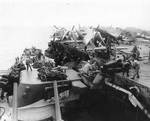
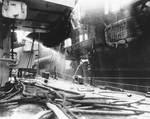
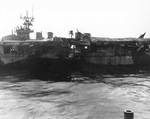
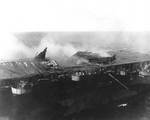
See all 24 Oct 1944 photos
Pacific Ocean
- Zuikaku launched 29 aircraft, her final offensive operation. ww2dbase [Zuikaku | Philippine Sea | CPC]




See all 24 Oct 1944 photos
25 Oct 1944
Pacific Ocean
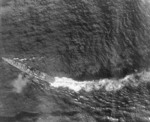

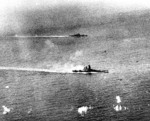

See all 25 Oct 1944 photos
Pacific Ocean
- Off northeastern Luzon, Philippines, aircraft from US Navy Task Force 38 attacked the Japanese carrier force consisted of fleet carrier Zuikaku and light carriers Zuiho, Chitose, and Chiyoda in the Battle off Cape Engaño. The Japanese force was escorted by two battleship-carrier hybrids (Hyuga and Ise; aircraft-less on this date), three light cruisers (Oyodo, Tama, and Isuzu), and nine destroyers at about 0830 hours, 26 minutes after those planes were detected by Zuikaku's radar. The overwhelmingly larger American force, under Admiral William Halsey, centered around fleet carriers USS Lexington, USS Intrepid, USS Essex, USS Franklin, USS Enterprise, further bolstered by a great many light carriers, battleships, cruisers, and destroyers. Zuikaku was damaged by skilled damage control teams extinguished the fires and corrected the listing by 0850 hours. Chitose was fatally damaged by the first attack wave, sinking at 0937 hours. At 0953 hours, a second attack wave struck, fatally damaging Chiyoda, leaving her dead in the water to be sunk by American destroyers later at 1655 hours. The second wave also damaged Zuiho's flight deck, the last functional flight deck of Vice Admiral Jisaburo Ozawa's force; Japanese combat air patrol planes in the air would need to ditch when they ran out of fuel. At 1032 hours, Ozawa transferred his flag from the damaged Zuikaku to Oyodo. At 1308, the Japanese sighted an incoming third wave of American aircraft. Six torpedoes struck Zuikaku, causing massive flooding and several fires in the hangar; the commanding officer addressed the surviving crew, ordered the lowering of the ensign, and gave the abandon ship order at 1358 hours; Zuikaku sank by the stern at 1414 hours. Zuiho suffered two torpedo, two bomb hits, and a great many near-misses during the third attack wave, and she was dead in the water at 1445 hours. At 1455 hours, a fourth wave struck, sealing the doom of Zuiho with ten near-misses, leading to Zuiho's commanding officer giving the abandon ship order; she sank at 1526 hours. ww2dbase [Philippines Campaign, Phase 1, the Leyte Campaign | Zuikaku | Jisaburo Ozawa | William Halsey | Marc Mitscher | Ise | Lexington (Essex-class) | Oyodo | Isuzu | Franklin | Tama | Cassin Young | Intrepid | Essex | Zuiho | Hyuga | Enterprise | Chiyoda | Chitose | Philippine Sea | CPC]
- In the Battle off Samar in the Battle of Leyte Gulf, destroyers USS Hoel and Heerman launched three Mark XV torpedoes at two different Japanese cruisers and missed. The torpedoes went on to advance on the battleship Yamato, the Japanese force flagship. Yamato’s evasive action took the force commander, Admiral Takeo Kurita, so far from the action that he effectively lost his ability to command the battle and likely contributed to his ultimate decision to break off the engagement and withdraw his force. ww2dbase [Yamato | Mark XV | Hoel | Takeo Kurita | Philippines Campaign, Phase 1, the Leyte Campaign | Philippine Sea | DS]




See all 25 Oct 1944 photos
6 Nov 1944
Pacific Ocean
Pacific Ocean
- USS Haddock fired 4 torpedoes at a transport in the Philippine Sea between Taiwan and the Philippine Islands, claiming 1 hit on a transport. ww2dbase [Haddock | Philippine Sea | CPC]
1 Dec 1944
Pacific Ocean
Pacific Ocean
- USS Segundo arrived on station in the Luzon Strait ww2dbase [Segundo | Luzon Strait, Philippine Sea | CPC]
2 Feb 1945
Pacific Ocean
Pacific Ocean
- The Japanese Army SB craft formerly known as Navy landing ship No. 115 was sunk by US aircraft in the Luzon Strait north of Luzon, Philippine Islands. ww2dbase [No. 101/103-class | Luzon Strait, Philippine Sea | CPC]
14 Feb 1945
Pacific Ocean
Pacific Ocean
- USS Archerfish fired eight torpedoes at a Japanese submarine or patrol ship in the Philippine Sea, scoring one hit and claimed a sinking. ww2dbase [Archerfish | Philippine Sea | CPC]
5 Jun 1945
Pacific Ocean
Pacific Ocean
- As the US 3rd Fleet steamed through a typhoon southeast of Japan, the leading 25-feet of USS Bennington's flight deck collapsed and hung drooping over her bow. ww2dbase [Bennington | Philippine Sea | DS]
Please consider supporting us on Patreon. Even $1 per month will go a long way! Thank you. Please help us spread the word: Stay updated with WW2DB: |
Search WW2DB

News
- » Wreck of Teruzuki Found (27 Jul 2025)
- » USS Orlean's Bow Found (22 Jul 2025)
- » The Emperor of Japan Planned to Honor WW2-era Japanese POWs in Mongolia (4 Jul 2025)
- » US State Lawmaker John Winter Caught Using Racial Slur "Jap" and Apologized (11 Jun 2025)
- » US Government Plans to Purge WW2 Information (17 Mar 2025)
- » See all news
Current Site Statistics
- » 1,182 biographies
- » 337 events
- » 45,119 timeline entries
- » 1,248 ships
- » 350 aircraft models
- » 207 vehicle models
- » 376 weapon models
- » 123 historical documents
- » 261 facilities
- » 470 book reviews
- » 28,409 photos
- » 365 maps
Famous WW2 Quote
"No bastard ever won a war by dying for his country. You win the war by making the other poor dumb bastard die for his country!"George Patton, 31 May 1944
Support Us
Please consider supporting us on Patreon. Even $1 a month will go a long way. Thank you!
Or, please support us by purchasing some WW2DB merchandise at TeeSpring, Thank you!